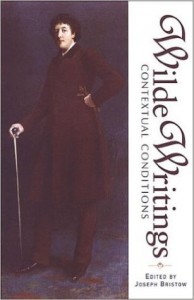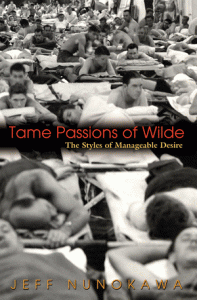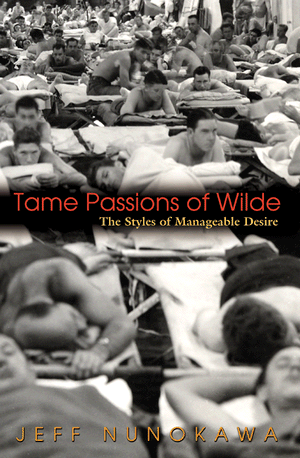 Wilde Writings: Contextual Conditions
Wilde Writings: Contextual Conditions
Edited by Joseph Bristow
Univ. of Toronto Press. 334 pages, $60.
 Tame Passions of Wilde: The Styles of Manageable Desire
Tame Passions of Wilde: The Styles of Manageable Desire
by Jeff Nunokawa
Princeton Univ. Press
164 pages, $17.95 (paper)
Two new books about the first icon in Anglo-American gay culture set out to accomplish the same goal, namely to present Wilde’s work in a historical context. They go about it in different ways and with varying degrees of success.
Wilde Writings collects thirteen thoroughly documented papers first presented as part of the series “Oscar Wilde and the Culture of the Fin de Siècle” at the William Andrews Clark Memorial Library in 1999. Starting with Joseph Bristow’s introduction, which shows how Wilde was portrayed during his time by various illustrators, it provides often fascinating background that alters and clarifies how we might read Wilde’s work in light of his contemporaries’ perceptions (or imagined perceptions) of it.
A few of the essays in Wilde Writings raise the question of whether reading Wilde from the standpoint of his “contextual conditions” risks limiting what he intended to say. Josephine M. Guy, at the end of her fine study of the social journalism of the day, concludes that “in the context of contemporary journalism the ‘social subject’ of ‘The Soul of Man’ starts to look less like a serious discussion about freedom and authority and more like a provocative (but occasional) contribution to local controversies about the values of those who called themselves Individualists,” one that “cannot bear the weight of detailed analysis.” To this assertion one might protest that Wilde was using an otherwise lightweight medium for more serious purposes, as he often did, and thus we should not restrict our interpretation of his work to what we know about his fellow journalists and their work.
Many of the other essays, however, offer unalloyed delights. Kerry Powell, for example, in her study of feminist writers such as Josephine Butler who were contemporaries of Wilde, shows that they anticipated the theories of the present-day Butler, namely Judith, in arguing that the presentation of gender is a social performance rather than the manifestation of some biological reality. From there, Powell argues convincingly that A Woman of No Importance, whether it has anything to do with homosexual blackmail or not, was definitely addressing the argument of some contemporary feminists that there are no natural forms of masculinity, and that those promulgated by society have no foundation in biology. On the other hand, Laurence Senelick’s rediscovery of an 1894 play by John Gray and French expatriate Marc-André Raffalovich, The Blackmailers, which dealt with homosexual blackmail, demonstrates convincingly that The Importance of Being Earnest, which was produced in the following year, was conceived with the earlier play in mind and was certainly contemplating the same topic.
In one of the most interesting essays, Talia Schaffer shows how The Picture of Dorian Gray fits into a tradition of novels by 19th-century English women writers, notably Ouida (1839-1908), which also featured dandies involved in intense male-male relationships. Once he meets the right woman, the dandy is masculinized and heterosexualized, so again we see how Wilde played with the tropes of his day. Still, and as scholars such as Bristow and Eve Kosofsky Sedgwick have demonstrated elsewhere, Schaffer shows that Wilde’s dandy was part of an established tradition that did not carry the gay connotations for his contemporaries that his trial would give it soon thereafter. On the same topic, Lisa Hamilton explains how other women novelists of the era, such as Sarah Grand and Emily Frances Brooke, used the figure of the effeminate man without any implication of homosexuality before and even after the Wilde affair.
Two of the essays, those by Stephen Arata and Ellis Hanson, propose that Wilde sought to give his life a form that would endow it with æsthetic value, particularly in his long letter to Alfred Douglas from prison, a truncated version of which we know as “De Profundis.” This is also the thesis that Jeff Nunokawa proposes in Tame Passions of Wilde. Gathering together four articles on the Irishman’s works that he had published previously, Nunokawa has added a final, longer essay and an introduction.
The latter is perhaps the most intriguing part of this volume. Here, expanding on his title, Nunokawa announces that he will examine Wilde for “those intentional and voluntary actions by which men not only set themselves rules of conduct, but also seek to transform themselves, to change themselves in their singular being, and to make their life into an œuvre that carries certain æsthetic values and meets certain stylistic criteria.” No one was more conscious of his public persona—nor more intent upon shaping it to particular ends—than Wilde, and a study of his life in terms of how and why he went about transforming it into a work of art would be fascinating indeed.
What follows, however, is five chapters of literary rather than biographical analysis. Some, such as “The Importance of Being Bored: The Dividends of Ennui in The Picture of Dorian Gray,” are well known already, though no less interesting for that. Others, such as “The Protestant Ethic and the Spirit of Anorexia: The Case of Oscar Wilde,” concentrate on situating certain of Wilde’s writings in his era, here against contemporary economic thought. Nunokawa argues that Wilde’s critique of the Protestant work ethic, with its seemingly endless delay of gratification, was tied to his more covert protest against a morality that sought to control the directions of sexual gratification.
In the end, I regret that Nunokawa did not undertake the project he set forth so intriguingly in his introduction, to examine how the author decided that he could be whoever he chose, regardless of society’s expectations, and set about to construct his life as a deliberate “work of art.” The gym bunny who spends hours each week pumping iron to mold the perfect body and the drag queen who painstakingly transforms himself into the perfect woman have a common ancestor in this Wilde. While it is fascinating to see how Wilde participated in and critiqued the ideas of his time, it would also be intriguing to see how he prefigured aspects of our own.
Richard M. Berrong is professor of French literature at Kent State University. His latest book, In Love with a Handsome Sailor, is a gay reading of the novels of Pierre Loti.






